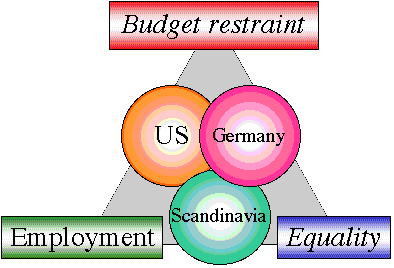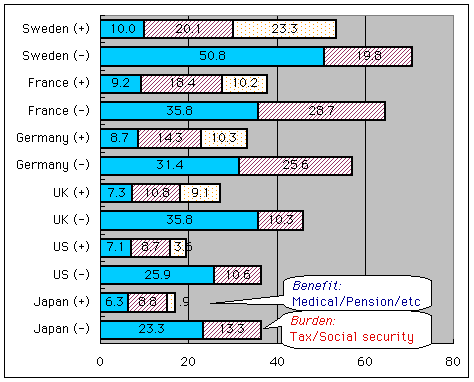What is the "Digital Divide"?
in viewing Consensus Community
Cat: ICT
Pub: 2001
#: 0105b
Tadamasa Kimura
01430u/18205r
Title
What is the "Digital Divide"?
デジタル・デバイドとは何か
Subtitle
in viewing Consensus Community
コンセンサス・コミュニティをめざして
Author
Tadamasa Kimura
木村忠正
Published
March, 2001
2001年3月
Index
Why?
This is a summary report of a reading circle of
Center for Global Communications, International University of Japan,
attended by Assist. Professor Tadamasa Kimura, Tokyo Metropolitan
Institute of Technology, the author of the above mentioned book,
in March 2001.
-
2001年3月に、国際大学Center for Global Communications
(Glocom) にて、昨年末に上梓した掲題のテーマの本に基づき、著者である東京都立科学技術大学の木村忠正助教授による読書会があった。
>Top 1. The Digital Divide in narrow and broad
senses:
- In 1999, US Ministry of Commerce published a sensational report
based on the investigation as of the end of 1998, pointing out "Falling
through the Net: Defining the Digital Divide" among an ethnic
group, yearly income, educational background in the environment
and usage of the Internet.
- The information network brought us a new type of activity accumulation
called "Network Proximity", which is getting rid of physical
time and space proximity in economic and social activities.
- Thus, "Digital Divide" in narrow meaning is defined
as there is decisive have or have-not divide linked to the social
differences, with even expanding trend in the accessibility of Internet.
While "Digital Divide" in broad meaning is that it is
closely related to emerging service economy and digital economy
which cause new structural reform of production of wealth and change
of distribution.
- Major countries showed visible change of industry structure in
the following aspects:
- Development of the service economy which can absorb 70% of
the total employment.
- Emergence of 'Fabless (Fabrication-less) manufacture'
- Unofficial employment such as part-time or loan of staff as
well as increase of unemployment of mainly younger generation.
- Progress of M&A by global corporations.
- Importance of venture business and small-medium sized enterprise
(SME)
- The author warns with anxiety that the Japanese society seems
stubbornly refuse any change notwithstanding repeated emphasis on
informatization, or recently IT revolution (both terms sound Japanese
English), which could be a 'paradox of information society theory.':
unavoidable less children more elder population and stringency of
national finance omen shrinking and declining Japan, particularly
after the collapse of the bubble economy since 1990.
1.狭義と広義のデジタルデバイド:
- 1999年、米国商務省は、1998年末の調査によって、民族集団、年収、学歴によるインターネット接続環境に大きな格差があることを指摘し、「ネットワークからこぼれ落ちるデジタルデバイド」を定義し、大きな反響を呼んだ。
- 情報ネットワークは産業経済活動や社会生活の面で、物理的な時間・空間や地理的な近接性の意味をなくし、「ネットワーク隣接性」という新たな活動集積をもたらした。
- 従って、狭義のデジタルデバイドは「情報ネットワークへのアクセスを持つ・持たないが社会階層とリンクしており、かつその経済的・社会的格差が拡大傾向にあるデバイド」であるが、より広義のデジタルデバイドとしては「サービス経済、脱工業化の進展とデジタル経済とが結びつき、富の産出と分配の変化に伴う新たな構造的な再編成」が生じていることに着目すべきである。
- この間、主要国における産業構造の変化が進展している。
- サービス産業の拡大 (70%の雇用)
- 工場をもたない「ファブレス・メーカ」の登場
- パートタイムや派遣社員など非正規雇用増大。若年層を中心に失業率が深刻化。
- グローバル企業によるM&Aの進展
- ベンチャーやSMES(Small & mideium-sized enterprise)の重要性
- 著者の危惧は、「情報化」、最近ではIT革命 (これらはいずれも和製英語?) の重要性が提言されているにも関わらず、日本社会は変化を拒み続けているように思える
(情報化社会論のパラドックス) 。さらに少子高齢化、財政の逼迫など、日本社会が縮小し衰退する予兆を前にしながら、日本社会はバブル経済崩壊後、たた呆然とたちすくんでいるいように見える点である。
>Top Remarks:
- Gini's law (by an Italian statistician): an index of unevenness
of distribution of income: 0 means complete equal distribution,
and 1 means monopoly state by one person; Europe shows
around 0.3 (Scandinavia 0.2) and South America 0.5-0.6.
- 1995 is the year when business sector discovered the Internet: BI=Before Internet means before 1995
while AI=After Internet means after
1995.
- Advance consumption society after 1970's features more importance
of image or design sensitivity rather than practical function
of commodities. (the age of 'semiotics')
- This informatized networked society can be expressed as Post
Advanced Consumer Society (PACS).
注)
- ジニ係数:所得分布の不均等度の指標:0は完全平等分配、1は一人独占状態を示す。欧州は0.3程度 (北欧は0.2) 、南米は0.5-0.6
- 1995年は「ビジネスがインターネットを発見した年」、95年以前は BI=Before
Internet、95年から AI=After Internetともいう。
- 1970年代以降の高度消費社会においては、モノが実用的な機能よりむしろイメージやデザインなど感性に訴える要素が縦横になった。
(記号主義)
- この情報ネットワーク社会の特性をポスト高度消費社会 (PACS=Post Advanced Consumer Society)
と表現される。
>Top 2. Emergence of Digital
Economy:
- US continues unprecedented prosperity from 1990's; maintaining
its 4% growth rate with 2% inflation rate, and 4% unemployment rate
since 1997; it is expressed as the economic growth without inflation,
leaving EU and Japan far behind.
- This motive power is owing to new economy of IT producing industries;
whose share is 6% level of GDP in early 1990's but reached 8.3%
in 2000. The scale of IT industry grew 2.5 times from $300 billion
in 1990 to $750 billion in 1997. However the employment in IT industry
shares only 5% of all workers from 3.9 million in 1992 to 5.2 million
in 1998.
- Also it should be noticed that yearly income tends to spread among
industries; $58,000 in IT industry, which is almost double of $31,000
as the average of private sector.
2.デジタル経済の出現:
- 米国は、1990年代から未曾有の好景気が続いている。97年以降の成長率は4%台を維持し、インフレ率は2%、失業率は4%と、インフレなき持続的経済成長を達成し、EU、日本にくらべ独り勝ちの様相を呈している。
- この原動力が、IT生産産業 (IT Producing Industries) というニュー・エコノミーであり、GDP比率も90年代初頭には6%台だったが、2000年には8.3%に達した。IT産業規模も3000億ドル/90年から7500億ドル/97年へと2.5倍に成長した。但し、IT産業の雇用は、390万人/92年から520万人/98年へと全労働人口の5%に過ぎない。
- 留意すべきは、広がる年収格差である。IT産業での平均年収は、$58,000/年であり、私企業の$31,000/年のほぼ2倍に達している。
>Top 3. "Trilemma"
in Service Economy:
- Torben Iversen and
 Anne Wren showed that there is "trilemma"
in the service economy of the major advanced countries; there is
a choice among policy targets of 'Balance of finance', 'Employment'
and 'Less Income Balance.' Either target could be sacrificed just
like the trilemma. There are following three ideal types:
Anne Wren showed that there is "trilemma"
in the service economy of the major advanced countries; there is
a choice among policy targets of 'Balance of finance', 'Employment'
and 'Less Income Balance.' Either target could be sacrificed just
like the trilemma. There are following three ideal types:
- 1) US Neo-Liberalism;
leaving most services to the market mechanism, causing not so heavy
financial burden, but will expand income difference.
- 2) German Christian Democracy;
conceding to strong industrial unions, without causing heavy financial
intervention, but cannot solve high unemployment ratio.
- 3) Scandinavian Social Democracy; creating more employment opportunities by public services, which
contributes redistribution of the income, but causing heavy financial
burden.
- After the collapse of bubble economy in the first half of 1990's,
Scandinavian countries could accomplish economic development through
concentrating IT industry in the latter 1990's; actually no more
digital divide as shown 70% personal and 90% small-medium sized
enterprises utilization of Internet. The above 3) Scandinavian model
seems to succeed to overcome the trilemma.
- Remarks:
Scandinavia countries consists of Denmark, Finland, Sweden, Norway
and Iceland.
IT Bill in 1996 by the government targeted Confidence, Competence
and Accessibility.
- Remarks:
The service industry is a field which is hardly measured by production
efficiency, could not be stockpiled and performed synchronously
unlike usual industrial model. There are following segments:
(In Japan, the following item 2. is bigger.)
- Producer Service: Professional services to enterprise, Finance,
Insurance and Real Asset services.
- Distribution and Logistics Service: Retail, Wholesale, Transportation,
and Communication services.
- Services for an individual: Hotel, Restaurant, Entertainment
& Culture, and Services for home and an individual.
- Social Service: Government, Military, Medical, Education
and other services.
3.サービス経済トリレンマ:
- Torben Iversen および Anne Wrenは、主要国の経済においては、「政府び財政均衡」「雇用確保」「所得均衡差」の3つは三者択一の状況であり、どれか一つは犠牲とならざるを得ない
(トリレンマ) 。政策としては、以下3つの理念型がある。
- 1) 米国型ネオ・リベラリズム:
サービスを市場原理に任せることで、財政負担は少なくなるものの、所得格差は拡大する。
- 2) ドイツ型キリスト教民主主義:
産業別組合が強力で、かつ財政も過度に介入せず、所得格差は拡大しないが、一方失業率は高い。
- 3) 北欧型社会民主主義:
政府はサービス部門の拡大で雇用を創出し、所得の再分配にも関与するが、財政負担も大きくなる
- 特に、北欧諸国は、90年前半のバブル経済崩壊後、IT産業を軸にした経済発展を遂げ、90年代後半には、インターネットの個人利用率70%、中小企業での利用率90%と大きなデジタルデバイドを生じなかった。上記の中では、3)
の北欧型モデルがトリレンマをうまく克服できているように思える。
- 注:
北欧諸国:デンマーク、フィンランド、スウェーデン、ノルウェー、アイスランドの5ケ国。
北欧での1996年のIT Billでは、政府によるITへのConfidence (信頼) 、Competence (能力開発)
、Accessibilityの拡大を目標とした。
- 注:
サービス産業の分類:サービス産業の分野は、生産効率で測ることが困難で、在庫することが不可能で、サービスを同時に行うことが必須であり、従来の工業化モデルをあてはめにくい。この分野は以下に分類できる。
なお、日本では、2. の割合が大きい。
- プロデューサー・サービス:
事業所向け専門サービス、金融、保険、不動産サービス
- 分配運搬サービス:
小売り、卸売り、交通運輸、通信サービス
- 個人向けサービス:
ホテル・飲食、娯楽・文化、家庭、個人向けサービス
- 社会的サービス:
行政・軍事、医療、教育、その他サービス
>Top 4. For Consensus
Community:
- What Japan targets at the cost of losing what? (Exchange
rate: $1=¥110)
- Financial deficit:
FY2000 budget's scale is $773 billion while tax income $442B; the
loss is national debt $296B. The cumulative debt is surprising $5,864B
including national debt $4,410B (Cf: Japanese GDP $4,372B in 1999);
requiring its interest payment of $90B. Furthermore, bad debt of
postal saving & national investment & loan accrues $910B.
- Japanese minister of finance admitted 'it is a kind of catastrophic.'
in 2001/3
- Unemployment rate:
4.1%/1998、4.7%/1999, totaling 3.17 million jobless people (380K
increase from the previous year), and part-timers are increasing
in younger generation (male 610K and female 900K)
- Income difference:
Through 1990's vertical difference from higher to lower income levels
expanded, though middle class consciousness is prevailing.
- Population structure:
Indispensable trend of less children and more elder people (the
birth rate was 1.34 in 1999); Japanese total population turns to
decrease from 2005, with productive population (15-64 years old)
already declining from 1998. In 1995 the productive population shares
69.5% and elder people not less than 65 years old 14.6%, while in
2050 these shares change to 54.6% and 32.3% respectively. In 2030
two productive people sustain one retired person, while in 2050
five productive people must sustain three retired.
- The above index of Japan shows no exit of the said trilemma. Majority
Japanese people foresee that "the next generation could not
be happier than themselves." Does Japan really fall into a
shrinking society?

- As indicated in the chart, Japanese redistribution economy (=national
burden rate of tax and social security) is smaller than Europe and
almost same level as US. Although the Japanese advocate group-oriented
spirit, but in fact they behave egoistically; Japanese society features
"the priority of private intimacy which causes standstill situation
of public consciousness" and "judgment according to personally
related or non-related."
- Remarks:
If the enormous balance of national bond and local debit
regarded as the prepaid tax in future, the Japanese national
burden rate in 2000 exceeds 49%, which is bigger than UK.
4.共創社会をめざして:
- 日本は、何を犠牲にして何を得ようとしているのか?
- 財政赤字:
2000年の予算では、税収48.6兆円、予算総額85兆円。不足は国債32.6兆円。債務残高は、国債485兆円、地方債務と合わせると合計645兆円(GDPは、481兆円/99)利払いだけで10兆円、さらに郵便貯金と財政投融資の不良債権は100兆円と危機的状況。
- 日本の蔵相は"破局的"と表現 (2001/3)
- 完全失業率:
4.1%/98年、4.7%/99年(317万人、前年比38万人増加)。10代、20代中心にフリーターが増加中。97年には(男性61万人、女性90万人)
- 所得格差:
90年代を通じて、中流意識の反面、実際には上位から下位まで垂直方向に多様化が進行している。
- 人口構造:
少子高齢化は不可避(出生率は1.34/99年)。総人口は2005年をピークに減少に転ずる。生産年齢人口(15-64歳)はすでに98年より下り坂。95年当時、生産人口69.5%、65歳以上の老年人口14.6%だったか、2050年には、生産人口54.6%、老年人口32.3%に増加。2030年頃には2人で1人、2050年には5人で3人の高齢者を支えなければならない。
- 上記日本の指標には、トリレンマ解決の糸口が見えない。「次世代が自分の世代より幸せでない」という社会意識が主流を占める中で、日本は「縮み社会」に向かっているのではないかと危惧する。
- 左図のように、日本では、再分配経済(租税と社会保障の負担率、国民負担率=National burden rate)は、欧州より小さく、米国と同レベルである。この結果、日本人は理念としては集団主義を掲げつつも、実際の行動パターンは利己主義となって現れ、日本社会特有の「親密さのイデオロギー優先」によって「パブリックに対する判断停止」が生まれ、自分にとって親密かあるいは無関係かという「私事化」が充満している。
- 但し、日本の国債・地方債の大量発行は、将来の税金の前借りとみなすと、2000年度の国民負担率は49%を上回り、英国以上になる。
- >Top
- The users of mobile internet in Japan (as "iMode" of NTT-DoCoMo) has recently exceeded 20 million, which seems simple
extension of pager culture; through this media information handling
literacy could not be acquired like collecting, retrieving, editing,
transmitting information and collaboration with it.
- It is urged for Japan how to grow out of material-central industries
to emphasize more value-added "enable service industries"
utilizing information network such as finance, energy, medical,
communication, education, public and other professional services.
Scandinavian countries, in particular, will be good examples which
are aimed at "consensus community"
or "sustainable society", where IT and market mechanism
are used as measures of social objectives, and they proved to succeed
in overcoming the collapse of their bubble economy since the latter
of 1990's through emphasis of enable industries of value-added care
services.
- なお、iMode利用者が2千万人を突破したが、これはポケベル文化の延長であり、これのみでは本来の情報ハンドリング能力(情報収集、情報選択、情報編集企画、情報伝達、情報協業)が育たないのではないか。
- 日本は、モノ重視の産業経済を脱却し、他の産業活動を支えるEnableサービス産業(金融、エネルギー、医療、通信、教育、公務、専門サービス等)を情報ネットワークの活用によって付加価値を生み出すことが不可欠となる。
- そこでは特に、社会的目的を追求するための手段としてのITや市場原理活かし、90年代後半から日本同様のバブル経済を克服し、高付加価値産業とケアサービス産業などイネイブルサービス産業の充実による豊かで安心感のある社会を目指している北欧諸国をモデルとした共創社会(Consensus
Community)を目標としたい。
Comment
- The issue of "Digital Divide" seems not only simple
digital divide in computer literacy, but also contains more socially
serious divide or contraction within our society.
- Is this "Digital Divide" a kind of segmentation as class
in the information society; the class having digital ability vs.
another class not having digital ability.
- デジタル・デバイドの問題は、単なるコンピュータ・リテラシーにおけるデジタル・デバイドではなく、同時に我々の社会におけるもっと社会的に深刻なデバイトや矛盾を含む。
- デジタル・デバイドは、情報化社会におけるある種の階級の差なのだろうか? 即ち、デジタル能力を所有する階級と、それを持たない階級とに。
What is the "Digital Divide"? in viewing Consensus Community
|
Cat: ICTPub: 2001#: 0105b |
|
Tadamasa Kimura |
01430u/18205r |
Title |
What is the "Digital Divide"? |
デジタル・デバイドとは何か |
Subtitle |
in viewing Consensus Community | コンセンサス・コミュニティをめざして |
|---|---|---|
Author |
Tadamasa Kimura | 木村忠正 |
Published |
March, 2001 |
2001年3月 |
Index |
||
Why? |
This is a summary report of a reading circle of
Center for Global Communications, International University of Japan,
attended by Assist. Professor Tadamasa Kimura, Tokyo Metropolitan
Institute of Technology, the author of the above mentioned book,
in March 2001.
|
|
>Top 1. The Digital Divide in narrow and broad senses:
|
1.狭義と広義のデジタルデバイド:
|
>Top Remarks:
|
注)
|
>Top 2. Emergence of Digital Economy:
|
2.デジタル経済の出現:
|
>Top 3. "Trilemma" in Service Economy:
|
3.サービス経済トリレンマ:
|
>Top 4. For Consensus Community:
|
4.共創社会をめざして:
|
|
|
Comment |
|
|